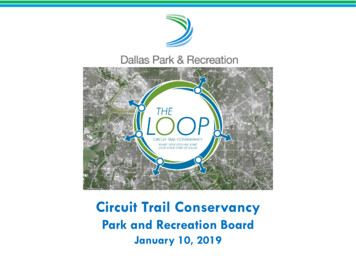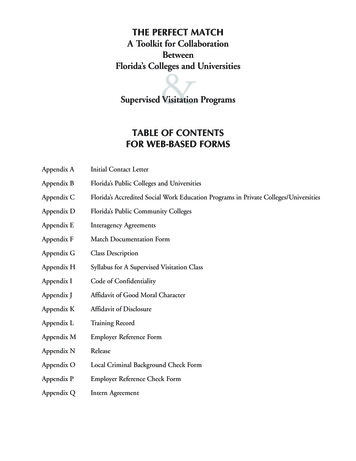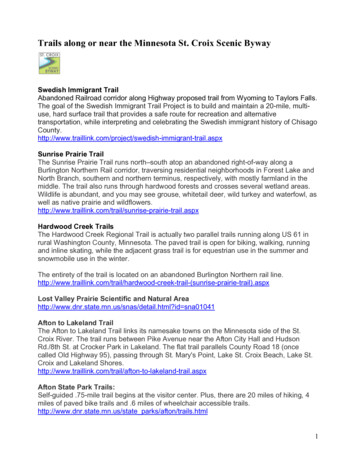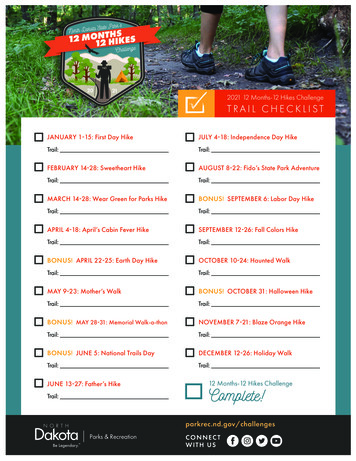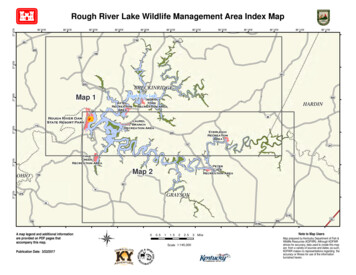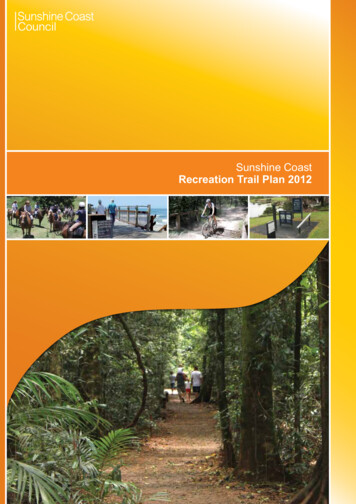
Transcription
Sunshine CoastRecreation Trail Plan 2012
Recreation Trail Reference GroupThe Recreation Trail Reference Group was established to provide input and guidance into thedevelopment of this Sunshine Coast Recreation Trail Plan 2012. Membership of the group wasvoluntary.The group consisted of representatives from the following organisations:Bushrangers Mountain Bike ClubDepartment of Communities Child Safety and Disability ServicesDepartment of Agriculture Fisheries and ForestryDepartment of National Parks, Recreation, Sport and RacingDepartment of Transport and Main RoadsFPQ Forestry Plantations QueenslandNoosa Biosphere Environment Board representativeQld Conference and Camping CentreRegional Development AustraliaSunshine Coast Area Trail Endurance RidersSunshine Coast Bushwalking ClubTourism Queensland. Sunshine Coast Regional Council t.qld.gov.auT 07 5475 7272 F 07 5475 7277Locked Bag 72 Sunshine Coast Mail Centre Qld 4560AcknowledgementsCouncil wishes to thank all the interested stakeholderswho have taken the time and energy to help guide thedevelopment of this strategy.DisclaimerInformation contained in this document is based onavailable information at the time of writing. All figuresand diagrams are indicative only and should be referredto as such. This is a strategic document which dealswith technical matters in a summary way only. Whilethe Sunshine Coast Regional Council has exercisedreasonable care in preparing this document it does notwarrant or represent that it is accurate or complete.Council or its officers accept no responsibility for any lossoccasioned to any person acting or refraining from actingin reliance upon any material contained in this document.2Sunshine Coast Recreation Trail Plan 2012Images supplied by Mitchell Bright, Ross Clarke, AdrianHolland, Mike Halliburton, Stylin Images, Sue Crocket,Mantis Design, Bike On Australia, Venture Cycles,Bushrangers Mountain Bike Club, D’Aguilar Range CycleClub, Irene Vlahakis, Greg Gardner Photography.
ContentsForeword. 5Executive summary. 611.11.21.31.41.5Introduction. 8Purpose. 8Demand. 9Scope. 10Methodology. 12Benefits of recreation trails. 1322.12.22.32.4Legislative and policy framework. 15International, national and state legislation. 15Queensland Government policy. 15Sunshine Coast Council context. 16Other Sunshine Coast planning documents. 1833.13.23.33.4Key issues and community input. 19Key issues. 19Community input. 21How we plan for recreation trails. 23Current performance. 2744.14.24.3Strategic directions. 29Our vision. 29Council policy direction. 30Strategic outcomes. 3055.1Strategic actions. 31How the actions work. 316Network blueprint. 387Funding. 408Management, implementation and review. 429Conclusion. 44Sunshine Coast Recreation Trail Plan 20123
Glossary. 45References. 46MapsRegional Map 1: Community input . 47Regional Map 2: Localities of interest. 48Regional Map 3: Existing trails by user type . 49Regional Map 4: Existing trails by categories . 50Regional Map 5: Trail Network Blueprint. 51FiguresFigure 1: Top ten physical activities 2009. 9Figure 2: Council’s endorsed policy framework. 17Figure 3: International Mountain Biking AssociationTrail Difficulty Rating System. 25TablesTable 1: Lengths used to determine category by user groups. 24Table 2: Level of difficulty for walking. 25Table 3: Trail supply by land manager. 28Table 4: Strategic outcomes and principles. 30AppendicesAppendix 1: User group activities defined . 53Appendix 2: Summary of review of relevant legislation and policies. 55Appendix 3: Current performance. 57Appendix 4: Recreation Trail Network Blueprint (detailed). 62Appendix 5: Recreation trails desired standard of service . 704Sunshine Coast Recreation Trail Plan 2012
ForewordRecreation trails are for stepping outside,stretching the legs and exploring the greatoutdoors whether it be on foot, mountainbike or horse. They provide access tomany treasures hidden within the naturalenvironment such as waterfalls, bubblingcreeks, spectacular view points, placeswhere koalas live, rainforests, wildflowers,mangroves and more.Urban recreation trails are often short pathwayswithin the urban park network and on roadreserves. For example, the planned coastalpathway will be a 90 kilometres pathway forpeople to access at many points along thecoastline. Rural trails are generally longerand are located within environment reserves,national parks or forest plantations on theCoast.Sunshine Coast recreation trails are often foundin areas of scenic beauty such as along thecoastline, over mountain peaks, adjacent torivers and through forests. They are known toprovide significant health, social, environmental,heritage, educational and recreational benefitsto the whole community.Trails for motorised activities are addressedwithin Sunshine Coast Council’s Difficult toLocate Sports Study. Trails for cyclists areincorporated into the Sunshine Coast ActiveTransport Plan 2011-2031. Water basedrecreation activities, including canoe trails, isanother area for future recreational planning onthe Coast.Trails also have a significant economic benefitfor the region in the growing eco-tourismindustry. Many recreation trails on the Coastare managed by Sunshine Coast Council.Trails are also managed by the Department ofNational Parks, Recreation, Sport and Racing(DNPRS&R), Forestry Plantations Queensland(FPQ) and Seqwater.The Sunshine Coast Recreation Trail Plan 2012has been developed to plan for an equitablesupply and diverse range of high qualitywalking, mountain bike riding and horse ridingtrails in urban and rural areas on the Coast bythe Sunshine Coast Council.The Sunshine Coast Recreation Trail Plan 2012has been developed in partnership with otherland managers associated with the Coast’srecreation trails and aims to facilitate furthertrail development across the region.The Sunshine Coast Recreation Trail Plan 2012forms part of Council’s vision for the SunshineCoast to be Australia’s most sustainable region– vibrant, green and diverse.Sunshine Coast Recreation Trail Plan 20125
Executive summaryThe Sunshine Coast provides a rangeof trails for the enjoyment of locals andvisitors. The landscape of the SunshineCoast is a significant contributor to thediversity of trails from hinterland ranges,beaches, volcanic plugs, heathland, pineplantations, rivers and creek systems,rainforest and eucalypt forests.Walking is the most popular physical activity forpeople in Australia and Queensland.The significant economic, environmental,cultural heritage, recreational, social,educational and health benefits recreation trailsprovide for the community are recognised byCouncil.The Sunshine Coast Recreation Trail Plan 2012is developed to fulfil an action of the SunshineCoast Open Space Strategy 2011.The Sunshine Coast Recreation Trail Plan2012: considers pathways provided for the primarypurpose of recreational activities such aswalking, horse riding and mountain bikeriding reviews existing legislation and local policy toidentify impacts on trail development analyses the current and future level ofsupply, distribution, range and diversity ofexisting signed recreation trails and thequality of Council managed trails within theSunshine Coast6Sunshine Coast Recreation Trail Plan 2012 examines the key issues relating torecreation trail provision for walkers,mountain bike riders and horse riders withinboth an urban and non urban environmentseeks to improve equity in the supply of trailsacross the region and access to urban trailsby activating the open space network forimproved health benefitsattempts to address the complexity ofmultiple tenure by recommending strongpartnerships and collaboration to enableseamless and improved connectivity.Pedestrian and bicycle pathways which existprimarily to expedite modes of movementare addressed in the Sunshine Coast ActiveTransport Plan 2011-2031. In some instancesrecreation trails may share these samecorridors.During development of Sunshine CoastRecreation Trail Plan 2012 a comprehensiveconsultation process was undertaken. Thefeedback assisted in identifying key issues,critical matters, new trails, and informed the traildevelopment priorities.The overarching vision of Sunshine CoastRecreation Trail Plan 2012 is to:Ensure a variety of trails are available forresidents and visitors so they may safelyenjoy the Sunshine Coast landscape onmountain bike, horse back or by walking.
Strategic outcomes and principles are identifiedin Sunshine Coast Recreation Trail Plan 2012to achieve the following vision: Robust EconomyThe trail network supports the emerging ecotourism industry.Ecologically SustainabilityThe biodiversity values of the areas throughwhich the trails traverse are protected.Innovation and CreativityThe recreation experience of the trail user isenriched by the integration and celebration ofartistic and thematic expression.Health and WellbeingOur community has good access to a varietyof well located and designed recreation trailsthat encourage a wide range of people toparticipate actively.Social CohesionTrails link people to the cultural,environmental and geographical landscapethrough which the trail passes and provideopportunity for people to come together.Accessibility and ConnectednessTrails link people and places safely, areaffordable and accessible to all members ofthe community.Managing GrowthA diversity of trails cater for the rapidlygrowing Sunshine Coast population andincreasing visitor numbers.Great GovernanceStrong partnerships and alliances withinCouncil, the State Government, communityand the private sector achieve highquality trails.manner with regard to trail users safety,environmental impacts and the land owners’business operations.The Sunshine Coast Recreation Trail Plan2012 promotes strong partnerships with otherland managers such as DNPRS&R, FPQ andSeqwater.A focus of the Sunshine Coast RecreationTrail Plan 2012 is the upgrade of existing trailsto improve capacity, safety, and provision toensure all residents have access to local tracks.The Sunshine Coast Recreation Trail Plan 2012is a long term planning document that will guidetrail development for the next ten to twentyyears. A review of Sunshine Coast RecreationTrail Plan 2012 is proposed to be undertakenevery five years.A critical component of Sunshine CoastRecreation Trail Plan 2012 is the networkblueprint. The blueprint provides guidance forthe upgrade, planning and development of bothexisting and new trails for the community.The linear nature of trails requires strategicpartnerships and advocacy with key landmanagers who manage their land for primarypurposes such as conservation, timberproduction and water storage.While access to these properties often providesa vital link or enhanced experience to trailusers it is imperative that these activities areundertaken in a respective and cooperativeSunshine Coast Recreation Trail Plan 20127
1 Introduction1.1 PurposeThe Sunshine Coast has a unique naturalenvironment with climatic conditions conduciveto the use of recreation trails for walking,mountain bike riding and horse riding. Acarefully planned and developed network ofrecreation trails provides an opportunity for theSunshine Coast to become a hub for recreationtrail users not only within Queensland but alsowithin Australia.Well connected communities is a strategicoutcome of the Sunshine Coast Open SpaceStrategy 2011 and is underpinned by theprinciple:Pathways, trails and corridors link people,places and biodiversity. Open space is the‘green frame’ of our built urban form, edgingour rivers and foreshores and connectingour community. Vibrant community hubs areconnected and linked to our homes. Movementof people and fauna is comfortable and safe.The purpose of the Sunshine Coast RecreationTrail Plan 2012 is to fulfil action 5.1.2 of theSunshine Coast Open Space Strategy 2011: 5.1.2 Ensure planning provides for walking,mountain bike riding and horse riding indifferent trail settings (urban and non urban).8Sunshine Coast Recreation Trail Plan 2012
The Sunshine Coast Recreation Trail Plan 2012seeks to: provide a guide for the future provision,embellishment and management of arecreation trail network on the SunshineCoast catering to non-motorised recreationalpursuits including walking, mountain bikeriding and horse riding inform Council’s planning, including theplanning scheme, strategic documents,funding allocations and operational activities guide Council and community decisionmaking with respect to trail development forthe next 10 years ensure a consistent and coordinatedapproach to the planning and allocation ofresources for trail development provide a framework to work collaborativelywith other land managers.1.2 DemandSufficient evidence demonstrates there isstrong demand for recreation trail infrastructureto be provided to Sunshine Coast residents andvisitors.The results of the Sunshine Coast online questionnaire undertaken duringdevelopment of the Sunshine CoastSport and Active Recreation Plan 20112026 revealed that multi-use trails innatural areas and walk/cycle paths arethe most important element of all sportand recreation infrastructure followedby sports fields. The questionnaire alsofound that the provision of multi-use trailsin natural areas is currently below theSunshine Coast community expectations.Figure 1 shows the top ten physical activitiesundertaken at least once by Australians duringthe 12 months prior to the 2009 Exercise,Recreation and Sport Survey1. Walking hadthe highest participation at 36.1 percent whichexcluded the 5 percent who went bushwalking.Figure 1: 2009 Exercise, recreation and sport survey top ten physical activities1&22Australian Sports Commission, Exercise, Recreation and Sport Survey Annual Report, Australian Sports Commission 2009.Sunshine Coast Recreation Trail Plan 20129
The survey also showed that the participationrate for walking: is higher for females (46 percent) than males(26.1 percent) is the highest form of participation across allage groups with the exception of the 15 to 34age group peaked at 55 to 64 years (52 percent),declining slightly among those aged 65 yearsand older (45.5 percent).Such results are not surprising as the 2001South East Queensland Outdoor RecreationDemand Survey identified that walking / naturestudy had the highest frequency of participationin South East Queensland with people walkingon average up to 70 times each per year i.e.more than once per week.1.3 ScopeThe Sunshine Coast Open Space Strategy 2011describes that Recreation Trails: are provided for the primary purpose ofrecreational activities such as walking, horseriding and mountain bike riding. Recreationtrails often traverse through a range of landtenures. These places have a different intentto the pedestrian and bicycle networks colocated with roads infrastructure, which existsprimarily to expedite modes of movement.In 2004 54 percent of Queensland residentsparticipated in trail-based activities includingwalking for exercise, cycling (including BMXand mountain bikes), bushwalking andhorse riding. In comparison 14.8 percent,14.2 percent, 10.1 percent and 6.9 percentparticipated in swimming, aerobics/fitness,football and soccer respectively3.These figures were similar to the 2008 figuresfor Queensland where the data highlightsthat participation in outdoor recreational, noncompetitive activities contribute to more thanhalf of all participation in physical activity inQueensland4.Additionally, the Sunshine Coast HinterlandNature-based Tourism Plan prepared forTourism Queensland and Tourism SunshineCoast identifies that participation in naturebased tourism activities including bushwalkingby visitors to Queensland is increasing.From the evidence available relating to currenttrends and an ongoing increasing populationgrowth on the Sunshine Coast, an increaseddemand on the existing trail network isanticipated.3410Australian Sports Commission, Exercise, Recreation and Sport Survey Annual Report, Australian Sports Commission 2004.Australian Sports Commission, Exercise, Recreation and Sport Survey Annual Report, Australian Sports Commission 2009.Sunshine Coast Recreation Trail Plan 2012
The scope of this Sunshine Coast RecreationTrail Plan 2012 focuses on recreation trails thatare: local, Sunshine Coast wide and regionaltrails, both signed and unsigned, that caterfor non motorised recreation pursuitssuch as: walking – leisurely strolls, strenuous treksin urban and rural environments andgeocaching/orienteering activities mountain bike riding – beginner, crosscountry, downhill and technical horse riding – 'weekend' casual riders,endurance riders, long distance riders(A definition for each user group activityis included in Appendix 1: User GroupActivities Defined). within the geographic area defined bySunshine Coast Council local governmentboundaries within the existing urban and non urban areasand future urban growth areas primarily on Council managed land, howeverSunshine Coast Recreation Trail Plan 2012does provide guidance for trail developmentwhere multiple tenures are encountered. To ensure Sunshine Coast RecreationTrail Plan 2012 assesses the full extent oftrails available on the Sunshine Coast andto avoid duplication of provision, all trailsincluding those not owned or managed byCouncil (e.g. trails within national parksand plantation forests) have been reviewedin the overall analysis.Further, recreation trails: can be differentiated from other pathwaysand cycle ways on the basis of theirtrip purpose, amenity (e.g. adjacent towater or located within a natural setting),surface treatment (often natural) and theinfrastructure which accompanies them have strong linkages with the naturalenvironment and open space includingplaces with high scenic amenity and culturalheritage values cater for non-competitive outdoor recreationactivities (e.g. bushwalking and mountainbike riding) provide infrastructure for formally organisedoutdoor sports and competitive events suchas orienteering, rogaining, cross countryrunning, endurance mountain bike racing,downhill mountain bike racing and endurancehorse riding often share pathways with the ActiveTransport Network, so planning ofthese networks should be undertakencollaboratively.Sunshine Coast Recreation Trail Plan 201211
1.4 MethodologyTo guide and inform the development of theSunshine Coast Recreation Trail Plan 2012,a Recreation Trail Reference Group wasestablished consisting of a range of community,Queensland Government, private sector andSunshine Coast Council stakeholders to ensureinput was obtained from not only those who usethe trails, but also those who build, maintain,manage and promote the trails.Development of the Sunshine Coast RecreationTrail Plan 2012 followed a number ofprogressive stages as outlined below.Stage 1: Determine existing situationa) Background research and context.b) Identify and map all existing signed andunsigned trails on both Sunshine CoastCouncil controlled and other managed land.c) Identify which trails are able to cater forthe various user groups (e.g. horse riders,walkers and mountain bike riders).Stage 2: Identify opportunities andconstraintsa) Identify trails proposed in former SunshineCoast Council planning trail documents.b) A comprehensive series of thirteencommunity workshops were conducted toidentify the community’s preferences forproposed trails and prioritisation criteria.c) Meetings with land managers, key trail usergroups, Councillors and staff workshops.Stage 3: Analysisa) Establish a Desired Standard of Service.b) Assess potential of unsigned trails to meetcriteria.c) Assess community proposed trails againstcriteria.d) Gap analysis – Assess improvementsneeded to the supply, diversity and range,and quality of identified traile) Prioritise and map proposed trails andopportunities.12Sunshine Coast Recreation Trail Plan 2012Stage 4: Consultation and adoptiona) Refine and finalise background study tosupport findings.b) Compile draft plan.c) Council endorsement for consultationd) Community and land manager consultatione) Finalise plan and adoption by Sunshine CoastCouncil.
1.5 Benefits of trailsThe benefits of trails to the Sunshine Coastcommunity are significant. Trails assist to makeour neighbourhoods a desirable, healthy placeto live by providing physical access throughour natural areas. Research from Australia, theUnited States, Canada, the United Kingdomand New Zealand acknowledges that trailsprovide a range of significant recreational,health, economical, environmental, culturalheritage, social and educational benefits to thecommunity. A summary of benefits is outlinedbelow.Economic Support local business services.Can attract new residents/businesses to anarea.Enhance property values.Encourage leisure tourism, eco-tourism andnature-based tourism and support outdoorrecreation activities provided by commercialtourism enterprises.Provide a significant economic benefit to thecommunity.Research indicates that users spend between 1.77 and 54.89/visit depending on wherethey come from and how long they are on thetrail.5The Riesling Trail (a 35 kilometres sharedused rail trail in South Australia) injects 1.08million per year into the Clare region.6Research at the Murray to the MountainsRail Trail in north eastern Victoria (one of thebetter known rail trails) found the averageexpenditure per person per day was approx 258.75Mike Halliburton Associates – Nambour to Coolum Trail Draft Feasibility Study (Dec 2010).Department of Infrastructure and Planning – Draft SEQ Active Trails Implementation Guideline 1 (June 2010).7Queensland Outdoor Recreation Federation (2009) SEQ Active Trail Management Systems.6Sunshine Coast Recreation Trail Plan 201213
Environment and cultural heritage Enable an appreciation and awareness of ournatural and cultural heritage.Provide incentives to preserve heritage,scenic and landscape values.Contribute to the improvement of theenvironment.Acknowledge indigenous people of the regionand may even follow their footsteps.Provide the opportunity for flora and faunacorridors to be shared with cultural heritageand recreational users.Health and wellbeing Recreation Provide excellent recreational opportunitiesfor families, mountain bike riders, historicalenthusiasts, horse riders, environmentalists,walkers, cross country runners and birdwatchers.Encourage people to go outside and recreatein nature which is good for the body, mindand soul (see health benefits below).Cater to both non-competitive outdoorrecreation and outdoor competitive sports.Provide places for people to walk their dogs.Social 14Provide opportunity for social interaction.Are utilised for walking, mountain bike riding,horse riding and by environmental/natureclubs who coordinate opportunities for socialinteraction in a natural environment.Encourage pride in community – connectpeople and places.Facilitate social bonding – interactionbetween diverse community members.Sunshine Coast Recreation Trail Plan 2012Encourage people to participate actively inoutdoor recreation activities and improvehealth. Research has shown the positivehealth outcomes include: stress reduction improved self esteem an increased sense of exhilaration enhanced physical capacity enhanced aerobic, cardiovascular andmuscular fitness improved functioning of the immunesystem enhanced environmental awareness reduced likelihood to suffer from lifestylerelated diseases.About 75 million annually can be saved in'health dollars' if an extra 10 percent of theSouth East Queensland population becomesmore physically active. Because trails canprovide hope of a healthier community andrelief from increasing medical costs, theyshould be seen as an essential component ofthe health care system, and warrant fundingaccordingly.Education Provide educational opportunities viainterpretation of places or things of interestalong the trail whether it be environmental,historical, artistic or cultural related and bysignage, hard copy or web based.Offer opportunities for organised learning thattakes place in the outdoorse.g. journey based experiences in whichstudents participate in a variety of adventurechallenges, scientific research and discovery.
2 Legislative andpolicy framework2.1 International, National and StateLegislationThere are a number of international, nationaland state legislation that need to be consideredwhen planning and developing trails. Theyinclude: UNESCO, RAMSAR Environment Protection and BiodiversityConservation Act 1999 Queensland Local Government Act 2009 Sustainable Planning Act 2009 Land Act 1994 Nature Conservation Act 1992 Forestry Act 1959 Water Act 2000 Recreation Areas Management Act 1988.A detailed review of legislation is contained inAppendix 2: Summary of Review of RelevantLegislation and Policies for Trail Planning andDevelopment.2.2 Queensland Government PolicyRelevant Queensland Policy to traildevelopment includes:South East Queensland Regional Plan2009 – 2031 Toward Q2 2008 – Tomorrows Queensland South East Queensland Active Trails Strategy2007 South East Queensland Outdoor RecreationStrategy 2010.The South East Queensland Active TrailsStrategy 2007 identifies nine new regionaltrails of which three have been, or are currentlybeing, developed, namely the Brisbane ValleyRail Trail Maroochy River Canoe Trail and theBoonah to Ipswich Trail. The proposed North Coast Mountain BikeTouring Trail, a 200 kilometres trail extendingfrom Brisbane to Yandina, is also containedin the South East Queensland Active TrailsStrategy 2007.A detailed review of each of the aforementionedpolicy directions is contained in Appendix2: Summary of Review of RelevantLegislation and Policies for Trail Planning andDevelopment.Sunshine Coast Recreation Trail Plan 201215
2.3 Sunshine Coast Council ContextThe Sunshine Coast Regional CouncilCorporate Plan 2009-2014 vision is for theSunshine Coast to be 'Australia’s mostsustainable region – vibrant, green, diverse'.In support of this vision the Corporate Planidentifies emerging priorities for the nextfive years.Underpinning the Council’s vision is theendorsed policy framework (refer to Figure 2:Council’s Endorsed Policy Framework).Within Council’s endorsed policy frameworka number of endorsed strategies and plansidentify specific actions relating to traildevelopment. These are outlined below.Sunshine Coast Open Space Strategy 2011Action 5.1.2 provides policy directions relatingto recreation trail development and identificationof key trails within each of the 44 localities ofinterest.The Sunshine Coast Recreation Trail Plan 2012fulfils this action.Sunshine Coast Biodiversity Strategy2010-2020The strategy seeks to: manage natural lands to retain the regionalcharacter, providing environmental,economic and lifestyle benefits,
The overarching vision of Sunshine Coast Recreation Trail Plan 2012 is to: Ensure a variety of trails are available for residents and visitors so they may safely enjoy the Sunshine Coast landscape on mountain bike, horse back or by walking. Executive summary The Sunshine Coast provides a range of trails for the enjoyment of locals and visitors.

